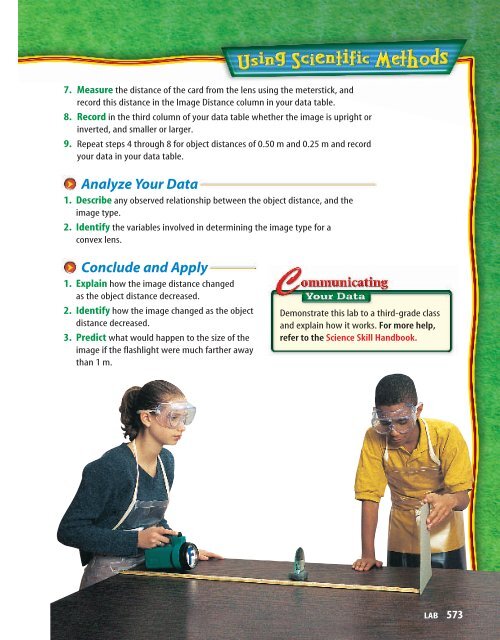7. Measure the distance of the card from the lens using the meterstick, <strong>and</strong>record this distance in the Image Distance column in your data table.8. Record in the third column of your data table whether the image is upright orinverted, <strong>and</strong> smaller or larger.9. Repeat steps 4 through 8 for object distances of 0.50 m <strong>and</strong> 0.25 m <strong>and</strong> recordyour data in your data table.Analyze Your Data1. Describe any observed relationship between the object distance, <strong>and</strong> theimage type.2. Identify the variables involved in determining the image type for aconvex lens.Conclude <strong>and</strong> Apply1. Explain how the image distance changedas the object distance decreased.2. Identify how the image changed as the objectdistance decreased.3. Predict what would happen to the size of theimage if the flashlight were much farther awaythan 1 m.Demonstrate this lab to a third-grade class<strong>and</strong> explain how it works. For more help,refer to the Science Skill H<strong>and</strong>book.LAB 573
SOMETIMESGREATDISCOVERIESHAPPEN BYACCIDENT!EyeglassesInventorUnknown“It is not yet twenty years since the artof making spectacles, one of the mostuseful arts on Earth, was discovered.I, myself, have seen <strong>and</strong> conversed with theman who made them first.”This quote from an Italian monk datesback to 1306 <strong>and</strong> is one of the first historicalrecords to refer to eyeglasses. Unfortunately,the monk, Giordano, never actually namedthe man he met. Thus, the inventor of eyeglassesremains unknown.The mystery exists, in part, because differentcultures in different places used sometype of magnifying tool to improve theirvision. For example, a rock-crystal lens, madeby early Assyrians who lived 3,500 years agoin what is now Iraq, may have been used toimprove vision. About 2,000 years ago, theRoman writer Seneca looked through a glassglobe of water to make the letters appear biggerin the books he read. By the tenth century,glasses had been invented in China, butthey were used to keep away bad luck, not toimprove vision.In the mid 1400s in Europe, eyeglassesbegan to appear in paintings of scholars,clergy, <strong>and</strong> the upper classes—eyeglasseswere so expensive that only the rich couldafford them. In the early 1700s, for example,This Italian engraving from the 1600sshows some different types of glasses.glasses cost roughly $200, which is comparableto thous<strong>and</strong>s of dollars today. By the mid-1800s, improvements in manufacturingtechniques made eyeglasses much lessexpensive to make, <strong>and</strong> thus this importantinvention became widely available to peopleof all walks of life.How Eyeglasses WorkEyeglasses are used to correct farsightedness<strong>and</strong> nearsightedness, as well as othervision problems. The eye focuses light rays toform an image on a region called the retinaon the back of the eye. Farsighted peoplehave difficulty seeing things close up becauselight rays from nearby objects do not convergeenough to form an image on the retina.This problem can be corrected by using convexlenses that cause light rays to convergebefore they enter the eye. Nearsighted peoplehave problems seeing distant objectsbecause light rays from far-away objects arefocused in front of the retina. Concave lensesthat cause light rays to diverge are used tocorrect this vision problem.Research In many parts of the world, people haveno vision care, <strong>and</strong> eye diseases <strong>and</strong> poor vision gountreated. Research the work of groups that bring eyecare to people.For more information, visitips.msscience.com/oopsThe Stapleton Collection/Bridgeman Art Library

















